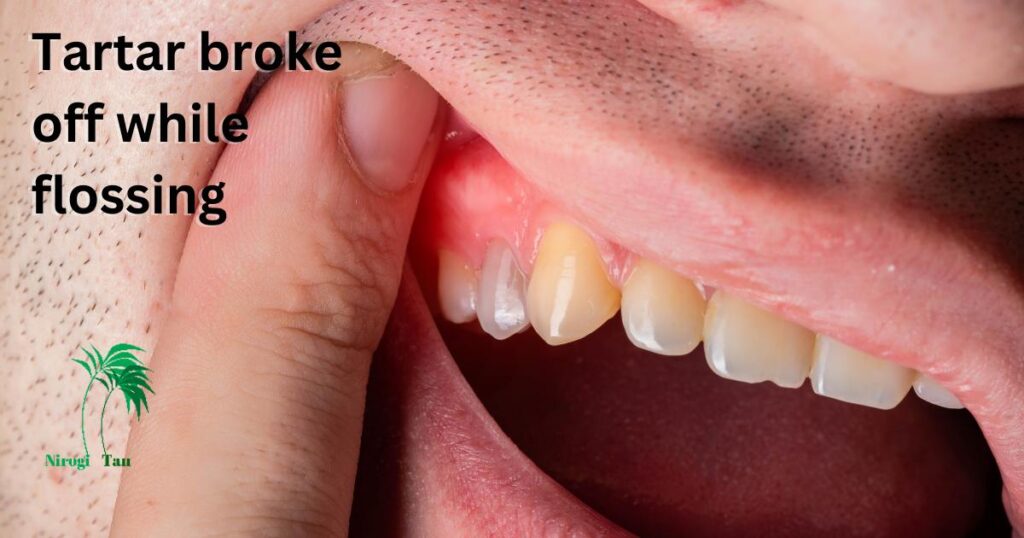When plaque is left on the teeth, a hard, yellow or brown deposit known as tartar, commonly referred to as dental calculus, develops. On teeth and gums, plaque, a soft, sticky film of germs, forms. It can become tartar if it is not eliminated by brushing and flossing. Plaque is easier to remove than tartar, which can only be done with the aid of specialized tools by a dentist or dental hygienist. Maintaining clean, healthy teeth is essential to prevent tartar buildup, which can cause gum disease and other dental issues. Although flossing is a crucial component of oral health, tartar often breaks off when people are flossing. This post will look at the reasons why this occurs and what you should do.
Describe Tartar
When plaque is left on the teeth, a hard, yellow or brown deposit known as tartar, commonly referred to as dental calculus, develops. On teeth and gums, plaque, a soft, sticky film of germs, forms. It can become tartar if it is not eliminated by brushing and flossing. Plaque is easier to remove than tartar, which can only be done with the aid of specialized tools by a dentist or dental hygienist.

Tartar accumulation can cause gum disease, a dangerous illness that can result in tooth loss and other medical issues. Gingivitis, the first stage of gum disease, can develop into periodontitis, which damages the bone and tissues that support the teeth. Gum disease can cause tooth loss and raise your risk of heart disease, stroke, and other illnesses if it is not treated.
Flossing Tartar: Why Does It Break Off?
For a variety of reasons, tartar might come off while flossing. The tartar is loose and prepared to come off, which is one of the most frequent causes. When you floss, the tartar could become loose and break off. Even though this may sound concerning, it’s actually a positive sign because it indicates that the tartar is no longer firmly bonded to your teeth.
Too-aggressive flossing is another factor that could cause tartar to come off when you’re cleaning your teeth. When flossing, excessive pressure could force the floss into the tartar and cause it to break off. Be careful when flossing and move the floss back and forth rather than pushing it down into the gum line to avoid this from happening.
Finally, if tartar has been accumulating for a long time, it may break off while flossing. If you haven’t been regularly flossing, tartar may have been accumulating for weeks, months, or even years. The tartar may shatter off in significant chunks when you begin flossing once more. Although this may be concerning, it’s crucial to continue flossing frequently to stop tartar buildup in the future.
It’s crucial to remember that, even though tartar might sometimes come off during flossing, regular flossing is still necessary to stop further development. By assisting in the removal of plaque and bacteria from in between teeth and along the gum line, flossing is a crucial component of good dental hygiene. If when flossing you encounter any discomfort, bleeding, or other oral issues, it’s critical to receive treatment or guidance, consult your dentist or dental hygienist.
What Should You Do If While Flossing, Tartar Breaks Off?
If tartar comes off while flossing, it’s crucial to keep brushing and flossing often to avoid further buildup.
Set up a meeting:
To get your teeth professionally cleaned, make an appointment with your dentist or dental hygienist. Any residual tartar can be removed by a dentist, who can also offer tips on how to avoid future development.
Check for bleeding:
It’s crucial to consult your dentist or dental hygienist if you suffer any pain or bleeding during flossing. While some blood may be expected when you initially begin flossing often, continuous bleeding could indicate gum disease or another dental issue.
Regular cleaning:
There are a few more things you can do to prevent tartar formation in addition to routine brushing and flossing. Avoiding sugary and starchy foods is one of the most crucial things you can do to prevent plaque development. Focus on eating a healthy, balanced diet that includes lots of fruits, veggies, and whole grains instead.
Use mouthwash:
To eliminate bacteria and freshen your breath, you could also think about using an antiseptic mouthwash. Additionally, mouthwash helps lessen the risk of gum disease and minimize plaque development. However, it’s crucial to pick an alcohol-free mouthwash because alcohol can dry out the mouth and cause other dental issues.
Gum chewing:
Chewing sugar-free gum after meals is another method for preventing tartar formation. Gum chewing increases salivation, which can aid in removing plaque and bacteria from the mouth. To prevent contributing to plaque and decay, it’s crucial to use sugar-free gum.
Frequent follow-up:
Finally, remember to schedule routine dental cleanings and examinations. Any tartar accumulation can be removed by your dentist or dental hygienist, who can also give you tips on how to keep your teeth healthy and clean. Additionally, they can spot any early indications of gum disease or other oral issues so that they can be treated before they worsen.
Read more: Side effects of denneroll
Conclusion
A frequent dental issue called tartar buildup can result in gum disease and other issues with your mouth’s health. Although flossing is an essential component of oral hygiene, tartar often comes off while flossing. Numerous factors, such as loose tartar, aggressive flossing, and long-term buildup, may contribute to this.
If tartar comes off while flossing, it’s crucial to keep brushing and flossing often to avoid further buildup. To eliminate any remaining tartar and receive guidance on how to avoid future accumulation, it’s nevertheless essential to make an appointment with your dentist or dental hygienist for a dental cleaning.
There are a few additional steps you may take in addition to routine brushing and flossing to avoid tartar formation. This includes maintaining a healthy weight, using an antibacterial mouthwash, chewing sugar-free gum, and visiting the dentist on a regular basis for cleanings and examinations. Maintaining good oral health and preventing tartar accumulation are both possible with proper dental and gum care. Do not hesitate to consult your dentist or dental hygienist if you feel any dental discomfort, bleeding, or other issues.
FAQs
During flossing or a tooth cleaning, tartar occasionally breaks off or falls off. Over time, tartar can get detached from the tooth and become loose, making it simpler to remove. On the other hand, if a lot of tartar is crumbling off or if you feel discomfort or bleeding during flossing or brushing, it could indicate a more serious tooth issue. In these situations, it’s crucial to make a dental consultation in order to have your teeth and gums examined and to get guidance on how to avoid tartar buildup in the future.
When tartar breaks off, it may appear as small, hard, granular bits that are yellow or brown in colour. Depending on how much tartar has accumulated on the teeth and how it breaks off, the size and form of the fragments can change. Tartar can occasionally come off in huge chunks or even in sheets, but it can also come off in a scattershot fashion. Continue practising good oral hygiene habits if you observe tartar breaking off during flossing or brushing to prevent additional buildup, and make an appointment with your dentist to have any residual tartar removed.
Since the procedure requires scraping and scaling the teeth to eliminate the accumulation, removing tartar is usually not pleasant. While some people could feel slight sensitivity or discomfort during the treatment, others might feel more discomfort or even pain. The discomfort is usually just momentary though, and it can be controlled with local anaesthesia or other types of painkillers. Many people experience comfort and cleaner teeth once the tartar has been removed, which can be a nice feeling. Tartar development can be avoided and healthy teeth and gums can be maintained with regular dental cleanings.
Following tartar removal, teeth rarely become loose. While some patients may suffer some mild discomfort or sensitivity following the treatment, this is often transient and should go away in a few days. The teeth may have been slightly loose prior to the tartar removal in some situations, especially if there was extensive tartar buildup or gum disease present, and the removal procedure may have added to the mobility of the teeth. The teeth should be stabilised and well healed, but this is uncommon, so a dentist should be consulted. All things considered, removing tartar shouldn’t harm the teeth permanently or make them loose.

